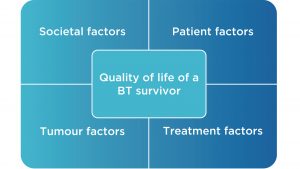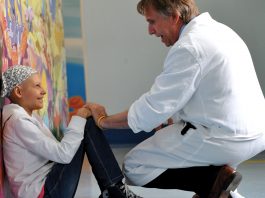Adequate follow-up procedures are essential in helping childhood brain tumour survivors adjust to society’s social and educational requirements.
Brain tumours are the second most common type of childhood cancer, accounting for nearly one third of all childhood cancer diagnoses. The survival rates have improved in recent decades, and currently nearly 80% of children diagnosed with a brain tumour (BT) survive long term.1 However, the survivors of young age onset BT often have several late-effects due to their prior tumour and its treatment, and their quality of life (QOL) may be compromised.
There are various factors potentially influencing QOL in survivors of childhood BT (Fig. 1).

The etiology of social difficulties is multifactorial and both BT-related risk and resilience factors as well as less studied non-BT-related factors such as parental style and socioeconomic status should be considered.2 Schulte and Barrera reviewed twenty articles which have reported level of social competence in childhood BT survivors.3 Most of the studies showed compromised social adjustment. The difficulties also seemed to be more pronounced than those seen in survivors with other types of childhood malignancies.4
It has been suggested that attention deficits derived from a BT and its treatment might be independently associated with social difficulties.5 However, as attention deficits might be related to a general decline in cognitive level and psychiatric morbidity which might also be associate with social functioning, this needs further clarification. The following factors are reported to increase the risk for social difficulties: female gender, young age at diagnosis, high risk treatment status (a treatment protocol including higher dose of cranial irradiation), posterior fossa syndrome, functional impairment, disfigurement, and lower cognitive levels.5-8
One study showed that the survivors with a history of a BT have an odds ratio (OR) of 0.23 for a life partnership and an OR of 0.43 for marriage in comparison with childhood leukaemia survivors.9 Cranial irradiation seemed to decline the probability for marriage.10 Childhood BT may also affect living arrangements in young adulthood and some BT survivors may live with their parents for a prolonged time. In a study of 32 medulloblastoma survivors who were at least 20 years of age, only 31% were living independently.11
Many childhood BT survivors are confronted with significant educational difficulties. In a Finnish study with 44 school-aged childhood BT survivors, 32% received some type of special education.12 The need for special education seemed to be higher with embryonal tumour survivors, with approximately three fourth of them attending some special education.11,13 Other survivor groups especially at risk for academic decline are young children diagnosed before seven years of age and children with mutism.14,15 In a report from childhood cancer survivor study group, siblings were more likely to graduate from college than childhood BT survivors with a relative risk of 1.4.10 A recent publication from Sweden showed that children diagnosed with a BT (N=475) before their 15th birthday (in 1988-1996), performed worse in such subjects as mother tongue, mathematics, and English as a foreign language compared to controls, and they also had delayed graduation to a greater extent.16
The frequency of health-related unemployment has been reported to be 25% for BT survivors and 1.8% for their siblings.17 A similar pattern has been seen in the frequency of people unemployed but seeking work, with figures being 10% and 2.7%, respectively. Factors found to be associated with unemployment of BT survivors are cranial irradiation ≥25Gy, female gender, increasing time since diagnosis, recurrence, and secondary cancer.17 In Sweden, it has been reported that 14% of young adults with a history of childhood BT receive handicap allowance and 23% receive disability pension.18 The frequencies among the age matched general population were 0.6% and 2.5%.
Results from nation-wide registry-based studies in Finland
Ahomäki et al studied new psychiatric diagnoses in five-year survivors of childhood cancer and reported that risk for organic memory dysfunction and disorders of mood, anxiety and personality were elevated in BT survivors compared with sibling controls.19 When the group analysed first antidepressant (AD) purchases in five-year survivors, all diagnostic groups, also BT survivors, showed higher hazard ratios for AD purchases than sibling controls.20 In another population-based study from Finland, 19.7% of childhood BT survivors were prematurely retired compared with 1.7% in an age-matched control group.21 In that study, the proportion of those BT-survivors with no education after comprehensive school was higher than in controls (33.5% vs. 23.0%), but OR for unemployment was not significantly elevated.
Furthermore, in a study of patients diagnosed with a BT at the age of zero to 15 years, between 1970 and 2004, and surviving at least five-years, late new morbidity was assessed using the Hospital Discharge Registry data.22 The five-year survivors had a significantly increased hazard ratio – such as for psychiatric disorders (HR 1.8), cognitive and developmental disorders (HR 16.6), neurological diseases (HR 9.8), and disorders of vision and hearing (HR 10.5), compared with the sibling cohort. However, radiation treatment did not explain all of the excess morbidity.
In a small group of five-year BT-survivors, it was shown that survivors had an impaired QOL in several dimensions, such as speech and usual activities.23 The qualitative interview of the same survivors revealed that the most important aspects having effect on their QOL were positive mental growth, negative conceptions concerning illness, living one day at a time, age at diagnosis, time since diagnosis, social relationships, learning disabilities and limitations in vocational opportunities, limitations in independent life, and changed understanding of the term ‘health’.23
We can conclude that paediatric BT survivors have significant neurocognitive and psychiatric sequelae that also affect their later QOL. This should motivate us to organise adequate, systematic follow-up procedures after BT in childhood. The survivors seem to assess social aspects to be more important than functionality for their QOL. Thus, interventions for social difficulties should be more actively developed, too.
References
- Madanat-Harjuoja, L.M., Pokhrel, A., and Kivivuori, S.M. et al. 2014. Childhood cancer survival in Finland (1953-2010): a nation-wide population-based study. Int J Cancer 2014;135:2129-34.
- Hocking, M.C., McCurdy, M., and Turner, E. et al. 2015. Social competence in pediatric brain tumor survivors: application of a model from social neuroscience and developmental psychology. blood cancer 2015;62:375-84.
- Schulte, F., and Barrera, M. 2010. Social competence in childhood brain tumor survivors: a comprehensive review. Supportive care in cancer 2010;18:1499-513.
- Barrera, M., Shaw, A.K., and Speechley, K.N. et al. 2005. Educational and social late effects of childhood cancer and related clinical, personal, and familial characteristics. Cancer 2005;104:1751-60
- Moyer, K.H., Willard, V.W., and Gross, A.M. et al. 2012. The impact of attention on social functioning in survivors of pediatric acute lymphoblastic leukemia and brain tumors. Pediatr blood cancer 2012;59:1290-95.
- Carpentieri, S.C., Mulhern, R.K., and Douglas, S. et al. 1993. Behavioral Resiliency Among Children Surviving Brain Tumors: A Longitudinal Study. J Clin Child Psychol 1993;22:236-46.
- Brinkman, T.M., Palmer, S.L., and Chen, S. et al. 2012. Parent-reported social outcomes after treatment for pediatric embryonal tumors: a prospective longitudinal study. J Clin Oncol 2012;30:4134-40.
- Holmquist, L.A., and Scott, J. 2002. Treatment, Age, and Time-Related Predictors of Behavioral Outcome in Pediatric Brain Tumor Survivors. J Clin Psychol in Med Sett. 2002;9:315-21.
- Wengenroth, L., Rueegg, C.S., and Michel, G. et al. 2014. Life partnerships in childhood cancer survivors, their siblings, and the general population. Pediatr blood cancer, 2014;61:538-45.
- Armstrong, G.T, Liu. Q., and Yasui, Y. et al. 2009. Long-term outcomes among adult survivors of childhood central nervous system malignancies in the Childhood Cancer Survivor Study. JNCI 2009;101:946-58.
- Frange, P., Alapetite, C., and Gaboriaud, G. et al. 2009. From childhood to adulthood: long-term outcome of medulloblastoma patients. The Institut Curie experience (1980-2000). J neurooncol 2009;95:271-9.
- Pietila, S., Korpela, R., and Lenko, H.L. et al. 2012. Neurological outcome of childhood brain tumor survivors. J neurooncol 2012;108:153-61
- Ribi, K., Relly, C., and Landolt, M.A. et al. 2005. Outcome of medulloblastoma in children: long-term complications and quality of life. Neuropediatrics, 2005;36:357-65.
- Lähteenmäki P,M., Harila‐Saari, A., and Pukkala, E.I. et al. 2007. Scholastic achievements of children with brain tumors at the end of comprehensive education: a nationwide, register‐based study. Neurology 2007; 69: 296‐305.
- Ris, M.D., Walsh, K., and Wallace, D. et al. 2013. Intellectual and academic outcome following two chemotherapy regimens and radiotherapy for average-risk medulloblastoma: COG A9961. Pediatr blood cancer 2013;60:1350-7.
- Lönnerblad, M., Van’t Hooft, I., and Blomgren, K. et al. 2020. A nationwide, population-based study of school grades, delayed graduation, and qualification for school years 10-12, in children with brain tumors in Sweden. Pediatr Blood Cancer 2020;67:e28014.
- Kirchhoff, A.C., Leisenring, W., and Krull, K.R. et al. 2010. Unemployment among adult survivors of childhood cancer: a report from the childhood cancer survivor study. Medical care 2010;48:1015-25.
- Hjern, A., Lindblad, F., and Boman, K.K. 2007. Disability in adult survivors of childhood cancer: a Swedish national cohort study. J Clin Oncol 2007;25:5262-6.
- Ahomäki, R., Gunn, M.E., and Madanat-Harjuoja, L.M. et al. 2015. Late psychiatric morbidity in survivors of cancer at a young age: a nationwide registry-based study. Int J Cancer 2015;137:183-92
- Ahomäki, R., Kero, A., and Koivisto, M. et al. 2019. Purchases of antidepressants after cancer at a young age in Finland. Int J Cancer 2019;144:1227-33.
- Ahomäki, R., Harila‐Saari, A., and Matomäki, J. et al. 2017. Non‐graduation after comprehensive school, and early retirement but not unemployment are prominent in childhood cancer survivors – a Finnish registry‐based study. J Cancer Surviv 2017;11:284‐ 94.
- Gunn, M.E., Lähdesmäki, T., and Malila, N. et al. 2015. Late morbidity in long-term survivors of childhood brain tumors: a nationwide registry-based study in Finland. Neuro Oncol 2015;17:747-56.
- Gunn, M.E., Mört, S., and Arola, M. et al. 2016. Quality of life and late-effects among childhood brain tumor survivors: a mixed method analysis. Psychooncology 2016;25:677-83.
- Singh, O., Meena, R.N., and Srivastava,V., et al. 2016. Impact of Brain Tumour Treatment on Quality of Life in Children: A Health Perspective. Neurooncol Open Access. 2016;1:1.
Päivi Lähteenmäki
MD, PhD, Senior Consultant in Paediatric Haematology/Oncology
Department of Paediatrics and
Adolescent Medicine
Turku University Hospital and
Turku University
+35823130670
paivi.maria.lahteenmaki@tyks.fi
https://www.utu.fi/en
Please note, this article will also appear in the second edition of our new quarterly publication.









